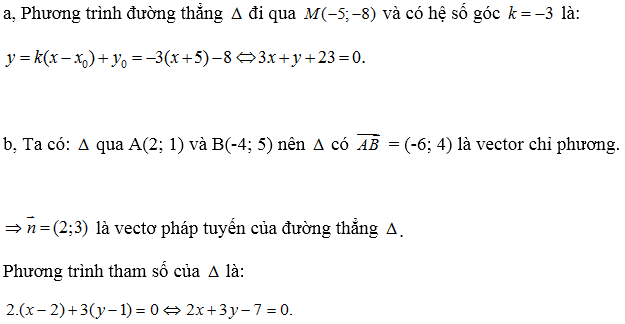Hãy nhập câu hỏi của bạn vào đây, nếu là tài khoản VIP, bạn sẽ được ưu tiên trả lời.

a,\(\Delta_a\) : 3 (x-1) - 2 (y-1) =3x-2y-1=0
b, \(\Delta_b\) : y=-\(\dfrac{1}{2}\)(x-2) =-\(\dfrac{1}{2}\)x =>\(\Delta_b\) : x+2y=0
c,\(\overrightarrow{AB}\)=(-2;-3) =>vtpt \(\overrightarrow{n}\)=(3;-2)
=>\(\Delta_c\): 3 (x-2) - 2(y-0) =0
=>\(\Delta_c\): 3x-2y-6=0
Lời giải
a) \(\Delta_a=3\left(x-1\right)-2\left(y-1\right)=3x-2y+5=0\)
b)\(\Delta_b:y=-\dfrac{1}{2}\left(x-2\right)-1=-\dfrac{1}{2}x\Rightarrow\Delta_b:x+2y=0\)
c) \(\Delta_c:\left(3+0\right)\left(x-2\right)+\left(0-2\right)\left(y-0\right)=3x-2y-6\)

a: =>|x+3|=|2x-1|
\(\Leftrightarrow\left[{}\begin{matrix}2x-1=x+3\\2x-1=-x-3\end{matrix}\right.\Leftrightarrow\left[{}\begin{matrix}x=4\\3x=-2\end{matrix}\right.\Leftrightarrow x\in\left\{4;-\dfrac{2}{3}\right\}\)
b: \(\left|x^2-2x\right|=\left|2x^2-x-2\right|\)
\(\Leftrightarrow\left[{}\begin{matrix}2x^2-x-2=x^2-2x\\2x^2-x-2=-x^2+2x\end{matrix}\right.\Leftrightarrow\left[{}\begin{matrix}x^2+x-2=0\\3x^2+x-2=0\end{matrix}\right.\)
\(\Leftrightarrow\left[{}\begin{matrix}\left(x+2\right)\left(x-1\right)=0\\\left(x+1\right)\left(3x-2\right)=0\end{matrix}\right.\Leftrightarrow x\in\left\{-2;1;-1;\dfrac{2}{3}\right\}\)
c: \(\left|3x^2-2x\right|=\left|6-x^2\right|\)
\(\Leftrightarrow\left[{}\begin{matrix}3x^2-2x=6-x^2\\3x^2-2x=x^2-6\end{matrix}\right.\Leftrightarrow\left[{}\begin{matrix}4x^2-2x-6=0\\2x^2-2x+6=0\end{matrix}\right.\)
\(\Leftrightarrow2x^2-x-3=0\)
\(\Leftrightarrow\left(2x-3\right)\left(x+1\right)=0\)
=>x=3/2 hoặc x=-1
d: \(\left|2x^2-3x-5\right|=\left|x^2-4x-5\right|\)
\(\Leftrightarrow\left[{}\begin{matrix}2x^2-3x-5=x^2-4x-5\\2x^2-3x-5=4x+5-x^2\end{matrix}\right.\Leftrightarrow\left[{}\begin{matrix}x^2+x=0\\3x^2-7x-10=0\end{matrix}\right.\)
\(\Leftrightarrow\left[{}\begin{matrix}x\left(x+1\right)=0\\3x^2-10x+3x-10=0\end{matrix}\right.\Leftrightarrow\left[{}\begin{matrix}x\left(x+1\right)=0\\\left(3x-10\right)\left(x+1\right)=0\end{matrix}\right.\)
hay \(x\in\left\{\dfrac{10}{3};-1\right\}\)
e: |5x+1|=|2x-3|
\(\Leftrightarrow\left[{}\begin{matrix}5x+1=2x-3\\5x+1=-2x+3\end{matrix}\right.\Leftrightarrow\left[{}\begin{matrix}3x=-4\\7x=2\end{matrix}\right.\Leftrightarrow\left[{}\begin{matrix}x=-\dfrac{4}{3}\\x=\dfrac{2}{7}\end{matrix}\right.\)

a) Vì parabol đi qua M(1; 5) nên tọa độ của M nghiệm đúng phương trình của parabol: 5 = a.12 + b.1 + 2.
Tương tự, với N(- 2; 8) ta có: 8 = a.(- 2)2 + b.(- 2) + 2
Giải hệ phương trình: ta được a = 2, b = 1.
Parabol có phương trình là: y = 2x2 + x + 2.
b) Giải hệ phương trình:
Parabol: y = x2 - x + 2.
c) Giải hệ phương trình:
Parabol: y = x2 - 4x + 2.
d) Ta có:
Parabol: y = 16x2 + 12x + 2 hoặc y = x2 - 3x + 2.

Lời giải:
\(27^{mx^3-2x^2+3x-2}=\frac{1}{9^{-mx^2-x+2}}\Leftrightarrow 3^{3(xm^3-2x^2+3x-2)}=3^{2(mx^2+x-2)}\)
\(\Leftrightarrow 3(mx^3-2x^2+3x-2)=2(mx^2+x-2)\)
\(\Leftrightarrow 3mx^3-x^2(2m+6)+7x-2=0\)
\(\Leftrightarrow (3x-2)(mx^2-2x+1)=0\)
Để PT ban đầu có ba nghiệm phân biệt thì \(mx^2-2x+1=0\) phải có hai nghiệm phân biệt khác \(\frac{2}{3}\). Khi đó:
\(\left\{\begin{matrix} m\neq 0\\ m(\frac{2}{3})^2-\frac{4}{3}+1\neq 0\\ \Delta' =1-m>0\end{matrix}\right.\Rightarrow \left\{\begin{matrix} m\neq 0\\ m\neq \frac{3}{4}\\ m<1\end{matrix}\right.\)
Đáp án D chính xác nhất, nhưng chưa quét hết nghiệm.

a) Ta tìm bán kính R2 = IM2 => R2 = IM = (2 + 2)2 + (-3 -32) = 52
Phương trình đường tròn (C): (x +2)2 + (y – 3)2 =52
b) Đường tròn tiếp xúc với đường thẳng d nên khoảng cách từ tâm I tới đường thẳng d phải bằng bán kính đường tròn:
d(I; d) = R
Ta có : R = d(I; d) = \(=\)
Phương trình đường tròn cần tìm là:
(x +1)2 + (y – 2)2 = =>( x +1)2 + (y – 2)2 =
<=> 5x2 + 5y2 +10x – 20y +21 = 0
c) Tâm I là trung điểm của AB, có tọa độ :
x = \(\dfrac{1+7}{2}\) = 4; y = \(\dfrac{1+5}{2}\) = 3 => I(4; 3)
AB = \(2\sqrt{13}\) => R =\(\sqrt{13}\)
=> (x -4 )2 + (y – 3)2 =13

a) Thay x, y trong phương trình y = ax + b bằng tọa độ của A và của B ta được hệ phương trình:
Vậy phương trình của đường thẳng đi qua A(0; 3) và là: y = - 5x + 3.
b) Thay \(x,y\) trong phương trình \(y=ax+b\) bằng tọa độ A và B ta được hệ phương trình: \(\left\{{}\begin{matrix}1.a+b=2\\2.a+b=1\end{matrix}\right.\)\(\Leftrightarrow\left\{{}\begin{matrix}a=-1\\b=3\end{matrix}\right.\).
Vậy phương trình đường thẳng cần tìm là: \(y=-x+3\).
c) Thay \(x,y\) trong phương trình \(y=ax+b\) bằng tọa độ A và B ta được hệ phương trình: \(\left\{{}\begin{matrix}15a+b=-3\\21a+b=-3\end{matrix}\right.\)\(\Leftrightarrow\left\{{}\begin{matrix}a=0\\b=-3\end{matrix}\right.\).
Vậy phương trình đường thẳng cần tìm là: \(y=-3\).

a) \(\varnothing\)
b) \(\left(a;c\right)\)\\(\left\{b\right\}\)
c) (\(a;b\)]
d) \(\left(a,b\right)\)

a: A=(-7/4; -1/2]
\(B=\left(-\dfrac{9}{2};-4\right)\cup\left(4;\dfrac{9}{2}\right)\)
\(C=\left(\dfrac{2}{3};+\infty\right)\)
b: \(\left(A\cap B\right)\cap C=\varnothing\)
\(\left(A\cup C\right)\cap\left(B\A\right)\)
\(=(-\dfrac{7}{4};-\dfrac{1}{2}]\cup\left(\dfrac{2}{3};+\infty\right)\cap\left[\left(-\dfrac{9}{2};-4\right)\cup\left(4;\dfrac{9}{2}\right)\right]\)
\(=\left(4;\dfrac{9}{2}\right)\)

Đáp án là \(3^2\)bạn nhé. Gồm: \(\overrightarrow{AA},\overrightarrow{AB},\overrightarrow{AC},\overrightarrow{BA},\overrightarrow{BB},\overrightarrow{BC},\overrightarrow{CA},\overrightarrow{CB},\overrightarrow{CC}\).